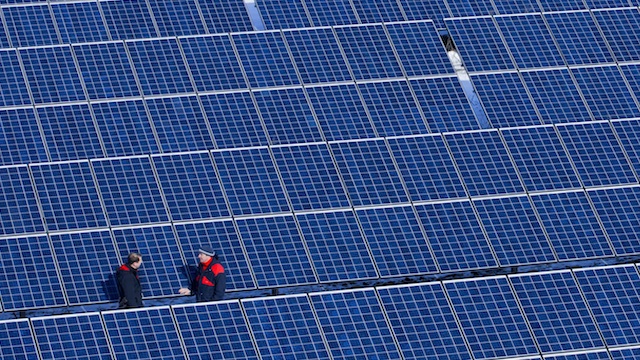SUMMARY
This is AI generated summarization, which may have errors. For context, always refer to the full article.

NEW YORK, USA – Renewables like solar and wind represent the fastest-growing source of energy power generation and will make up a quarter of the global power mix by 2018, the International Energy Agency said in a report Wednesday, June 26.
The IEA said that in 2016 renewable energy will overtake natural gas as a power source and will be twice that of nuclear, and second only to coal as a source of power.
The growth of renewables “is a bright spot in an otherwise bleak assessment of global progress towards a cleaner and more diversified energy mix,” said IEA Executive Director Maria van der Hoeven.
The growth of renewables — non-fossil fuels like hydropower, wind, solar, geothermal and bioenergy — has been bolstered by increased competitiveness compared with conventional energy, the IEA said.
The sector is growing especially fast in China and other developing and emerging countries.
The IEA said non-hydro renewable power, mainly wind and solar photovoltaics, is projected to grow from 4 percent of all power generation in 2011 to 8 percent in 2018.
Still, the IEA, an institute backed by major energy consuming countries, cautioned that the continued growth of alternatives to oil, gas and coal faces important challenges.
These include uncertainty about long-term government policies that discourages investment; reduced subsidies in some countries due to economic problems; and tough competition from other energy sources, such as the United States, where a boom in shale gas has made that fuel more competitive.
Van der Hoeven, unveiling the report in New York, said that policy reversals on renewables subsidies in Bulgaria, the Czech Republic and Spain have damaged progress.
She also criticized “stop and go decisions,” such as the annual US debate on whether to renew a key tax credit for some non-fossil energy sources.
Van der Hoeven said her comments emphasizing the need for a stable long-term policy were aimed at all governments, but that they were “timely” for Europe, where there is an active debate on whether to increase emissions reduction targets after 2020.
She praised US President Barack Obama’s energy and climate proposals unveiled Tuesday.
Obama’s polices constitute “a clear example of a target that goes beyond the four years of a presidential mandate, and I hope that other countries are going to follow that,” she said.
The report comes on the heels of recent research suggesting the threat of climate change is greater than earlier estimates.
An IEA report released earlier this month warned the world is on track to surpass by more than double the two-degree Celsius warming goal set by the United Nations, unless urgent measures are taken.
The IEA’s recommendations include curtailing coal-fired power stations and phasing out fossil fuel subsidies.
The report listed several examples where increased competitiveness have propelled renewable energy, such as Brazil, where onshore wind competes well with new gas-fired plants, and Australia, where wind is cost-effective next to new coal- and gas-fired plants with carbon pricing.
Onshore wind costs are close to competing with new coal-fired plants in South Africa.
OECD countries are expected to remain an important source of renewable growth, including Japan, which has enacted aggressive financial incentives to boost solar production.
But the biggest gains are expected to be in China, which is seen accounting for more than 40 percent of the total added capacity in the 2012-8 time frame. China has robust investments in hydropower, solar and wind.
However, the report notes that the country’s most recent five-year plan for energy development implies that coal will account for 65 percent of total power generation capacity in 2015. – Rappler.com
Add a comment
How does this make you feel?
There are no comments yet. Add your comment to start the conversation.